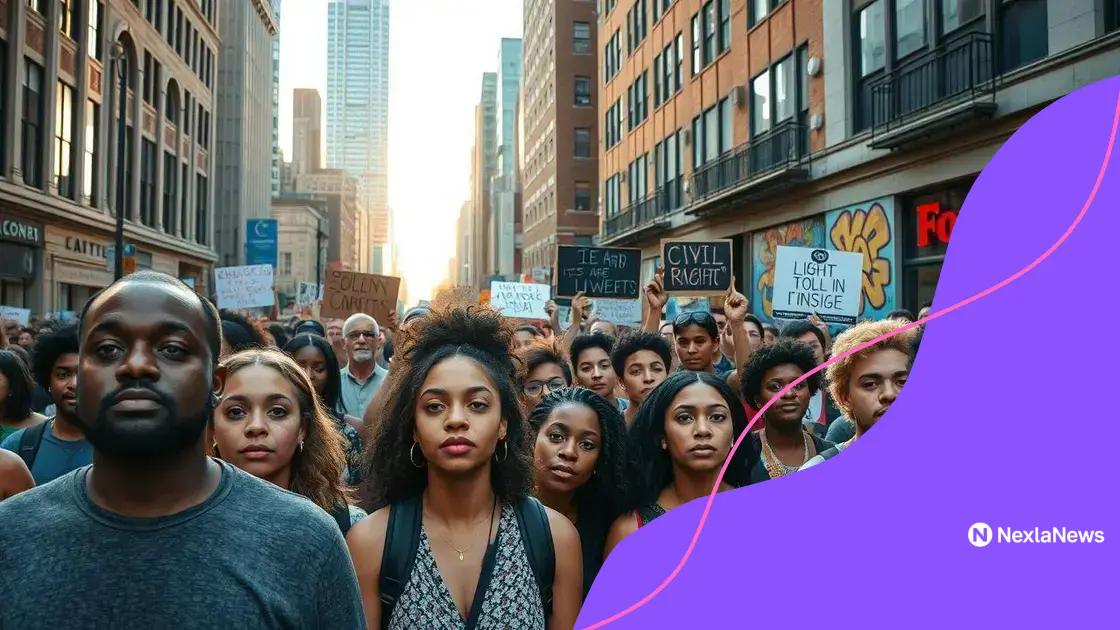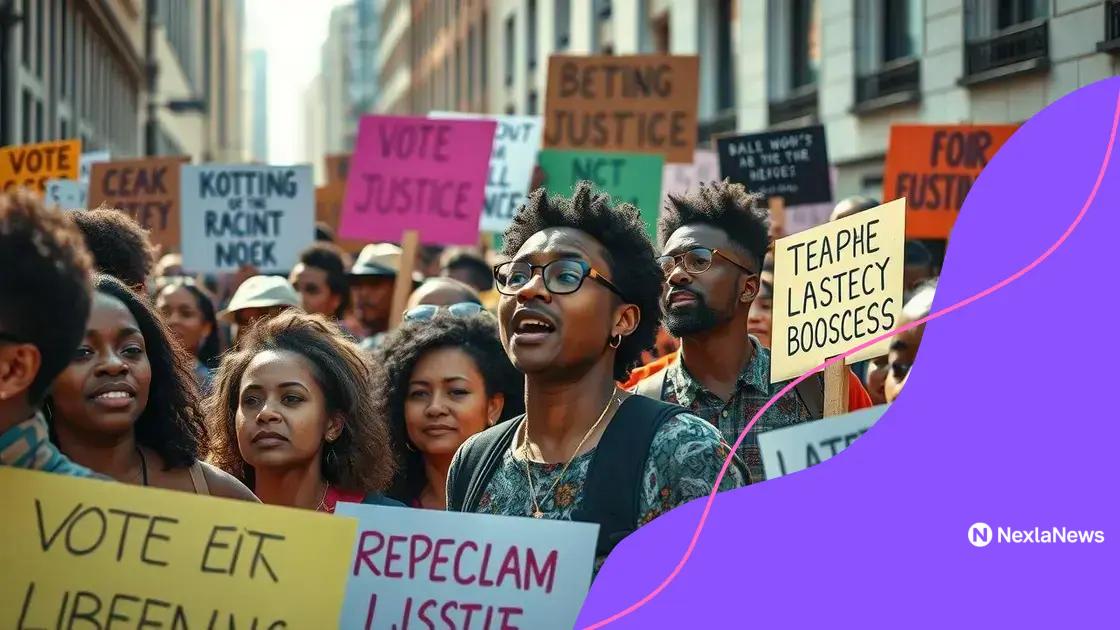Civil rights focus: understanding its impact today

The future of civil rights advocacy involves leveraging technology, embracing global perspectives, and fostering intersectionality to ensure a comprehensive approach to social justice and equality.
The civil rights focus shapes our society significantly, reminding us of the ongoing struggle for equality and justice. What does this mean for you and our communities? Let’s dive in.
Historical overview of civil rights movements
The historical overview of civil rights movements is essential to understanding civil rights focus today. These movements have been critical in shaping societal norms and laws that protect individuals from discrimination. Knowing their history can help us appreciate the struggles faced and the achievements gained.
Early Civil Rights Movements
In the United States, the fight for civil rights began in the early 20th century with organizations like the NAACP. This group worked tirelessly for the rights of African Americans, aiming to end segregation and promote equality.
Important events like the Brown v. Board of Education case in 1954 challenged segregation in schools. The court’s decision was a significant step towards equality. Rosa Parks and her refusal to give up her seat on a bus in Montgomery became symbols of the fight against injustice.
Key Events and Legislation
As the movement grew, it rallied support through various forms of protest. Notable events included:
- The March on Washington in 1963, where Martin Luther King Jr. delivered his famous “I Have a Dream” speech.
- The Civil Rights Act of 1964, which made discrimination illegal in many areas.
- The Voting Rights Act of 1965, ensuring that everyone could exercise their right to vote.
These milestones show how the civil rights movement evolved, gaining momentum through collective action and advocacy. As time passed, the focus shifted to other oppressed groups, expanding the vision of rights for all.
Understanding the historical underpinnings of these movements reveals their impact on today’s society. The principles of justice and equality continue to inspire modern activism. Every generation faces its challenges, but the fight for rights remains a vital part of the narrative.
Key figures in civil rights history
Key figures in civil rights history played crucial roles in shaping the civil rights focus that we recognize today. These individuals were not only courageous but also visionaries who inspired millions to join the fight for equality.
Martin Luther King Jr.
Perhaps the most famous leader of the civil rights movement, Martin Luther King Jr. advocated for nonviolent resistance. His speeches, including the iconic “I Have a Dream,” rallied support and brought national attention to civil rights issues.
Rosa Parks
Rosa Parks is known as the “mother of the civil rights movement” for her brave decision to refuse to give up her bus seat to a white man. This act of defiance sparked the Montgomery Bus Boycott, a pivotal moment in the fight against segregation.
- Rosa Parks’ actions highlighted the power of individual resistance.
- Her story emphasizes the importance of grassroots activism.
- She became an enduring symbol of the struggle for justice.
Another legendary figure is Malcolm X. Initially known for his fiery rhetoric and advocacy for black nationalism, Malcolm X later called for unity and cooperation among all races. His evolution in thought and approach added layers to the movement’s strategies.
Additionally, figures like Thurgood Marshall, the first African American Supreme Court Justice, played key roles in legal battles for civil rights.
These leaders collectively contributed to a broader understanding of civil rights, creating diverse strategies for advocacy. Their legacies continue to inspire new generations fighting for equality worldwide. Knowing their stories helps us understand the ongoing struggle for rights today.
Current civil rights issues and challenges

Current civil rights issues and challenges continue to shape the conversation around civil rights focus today. Despite the progress made over the years, many communities still face significant barriers. Understanding these modern challenges is essential for continuing the fight for equality.
Racial Discrimination
Racial discrimination remains a pressing issue in various aspects of life, including employment, housing, and law enforcement. Many people still experience systemic racism, which refers to policies and practices that maintain racial inequality. This discrimination can be overt or subtle, impacting the lives of countless individuals.
Voting Rights
Voting rights have come under threat in several states, with new laws aimed at restricting access to ballots, especially for minorities. Many advocate for the protection of voting rights to ensure every individual can participate in the democratic process. Important points include:
- The need for comprehensive voter registration.
- Protection against aggressive ID laws.
- Access to polling places in underserved areas.
These voting issues highlight the ongoing struggle to maintain equality in the political sphere. Activists are rallying to fight for legislation that secures these rights for all.
Additionally, economic inequality persists as a major challenge. Many individuals and communities face economic hardship due to disparities in education, employment, and income levels. Addressing economic justice is crucial for achieving true equality, laying the groundwork for a more fair society.
As movements continue to evolve, they address these ongoing issues. Organizing peaceful protests, advocating for policy changes, and raising awareness about civil rights matters are some strategies employed today. It is vital for individuals and communities to stay informed and engaged in these challenges, as they affect everyone in society.
Ways to promote civil rights today
Promoting civil rights today requires active engagement from individuals and communities. There are numerous ways to support the civil rights focus and create a more equitable society. By understanding these methods, we can all contribute to the ongoing fight for justice and equality.
Advocacy and Education
One effective way to promote civil rights is through advocacy. This can involve raising awareness about important issues, such as racial inequality and voting rights. Educational campaigns help inform the public about civil rights history and current challenges.
Here are some key ways to engage in advocacy:
- Participate in community discussions and workshops.
- Support and join civil rights organizations.
- Share educational resources on social media.
Education plays a vital role in understanding both historical and contemporary civil rights issues. When people are informed, they are more likely to stand up for justice.
Participating in Protests and Demonstrations
Participating in peaceful protests and demonstrations is another powerful method to promote civil rights. These events bring attention to specific issues, allowing voices to be heard.
Joining local marches, rallies, and events can strengthen community solidarity. Advocates gather to show support for equal rights for all.
Moreover, volunteering with organizations working on civil rights issues can amplify efforts. Engaging in grassroots movements fosters collaboration and builds networks that can lead to significant change.
Using technology and social media also plays a huge part in civil rights advocacy today. Online platforms allow for swift communication, organizing, and mobilization. Activists can share their messages widely, reaching people across various platforms.
In essence, there are many ways to promote civil rights today. From education to participation and leveraging technology, every effort counts in working toward a future of justice and equality.
The future of civil rights advocacy
The future of civil rights advocacy is shaped by ongoing challenges and new opportunities. As society evolves, so do the strategies to ensure a civil rights focus remains relevant and effective. Understanding these developments is crucial for those invested in the cause of equality.
Embracing Technology
Advocates are increasingly using technology to amplify their message. Social media platforms have become essential tools for organizing events and spreading awareness quickly. These digital spaces allow for real-time communication among supporters.
Some key aspects include:
- Online petitions that can reach thousands in a short time.
- Live-streaming events to engage a wider audience.
- Educational content shared through videos and articles.
This online activism fosters a sense of community and encourages more people to participate in civil rights efforts.
Global Perspectives
Another aspect shaping the future of civil rights work is the recognition of global issues. Many civil rights challenges are connected to broader human rights concerns around the world. Advocates are learning from one another and sharing methods of addressing similar problems.
Understanding how other countries approach civil rights can inform local strategies. This exchange of ideas can lead to innovative solutions for long-standing issues.
Moreover, the focus on intersectionality emphasizes that civil rights advocates must address diverse needs. This includes recognizing that individuals may face multiple forms of discrimination based on race, gender, sexuality, and other identities. Incorporating these perspectives ensures a more inclusive approach.
As future leaders emerge, mentorship and education become vital. Experienced advocates can guide newcomers, sharing knowledge about effective strategies and pitfalls to avoid. Supporting youth-led movements also energizes the advocacy landscape, bringing fresh perspectives and new voices to the forefront.
Overall, the future of civil rights advocacy is dynamic and progressive. Commitment to these causes will require flexibility, creativity, and collaboration. By leveraging technology, embracing global perspectives, and fostering new leaders, the movement can continue to evolve and make a meaningful impact.
In conclusion, the future of civil rights advocacy is bright and full of potential. As technology evolves, new tools will help us connect and organize. The shift towards global perspectives will foster collaboration and expand our understanding of human rights. By embracing intersectionality, advocates can ensure that all voices are heard and represented. Engaging the next generation through mentorship will strengthen the movement for years to come. With commitment and creativity, we can continue to make strides toward a more just and equitable society.
FAQ – Frequently Asked Questions about the Future of Civil Rights Advocacy
How is technology changing civil rights advocacy?
Technology is enhancing civil rights advocacy by enabling quick communication, online organizing, and spreading awareness through social media platforms.
What role does mentorship play in civil rights advocacy?
Mentorship helps prepare the next generation of leaders, guiding them through effective strategies and encouraging active participation in advocacy.
Why is understanding global perspectives important?
Understanding global perspectives allows advocates to learn from other movements, fostering collaboration and innovative approaches to challenges.
What does intersectionality mean in civil rights advocacy?
Intersectionality recognizes that people face multiple forms of discrimination, ensuring that advocacy efforts address diverse needs and experiences.
